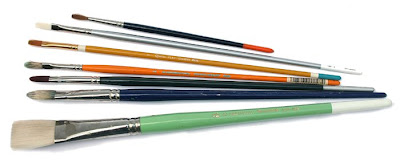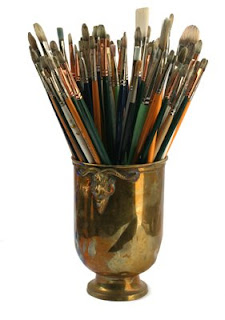Bristle brushes are good for keeping your painting direct and simple, with a greater likelihood of getting soft edges. Generally the stiffer the brush the softer the edges. I like flats and filberts. Brights are like flats, but shorter. The Silver company makes an "extra-long filbert," which has a wonderful touch.
 White nylon flats are excellent for detailed painting of architecture and technology. They’re available in widths as narrow as 1/4 of an inch to 1 inch wide brushes for laying in a transparent wash of thin paint. A flat brush should have a chisel tip, which you can use for a wide stroke or a thin line.
White nylon flats are excellent for detailed painting of architecture and technology. They’re available in widths as narrow as 1/4 of an inch to 1 inch wide brushes for laying in a transparent wash of thin paint. A flat brush should have a chisel tip, which you can use for a wide stroke or a thin line.Nylon brushes are fairly inexpensive, but they don’t last long. Most of the manufacturers, like Dick Blick, Grumbacher, and Simmons make versions of these, and they’re all pretty good.
 For small detail work, I use Kolinsky sable rounds. They're made from the reddish tail hairs of a kind of weasel, not a sable (which is a kind of marten). They’re intended for watercolor, but they work equally well for oil. These are the most expensive brushes, but they respond very sensitively to detail work.
For small detail work, I use Kolinsky sable rounds. They're made from the reddish tail hairs of a kind of weasel, not a sable (which is a kind of marten). They’re intended for watercolor, but they work equally well for oil. These are the most expensive brushes, but they respond very sensitively to detail work.The Winsor and Newton Series 7 has always been the standard, but they’re overpriced, and you can get good Kolinsky sables from Escoda, Silver, and other makers. Most often I use Raphael 8404, which is fairly priced, and as good as any others.

You do some really great work man
ReplyDeletePeace,
Joe y Elio
Can you explain how you clean them?
ReplyDeleteWhat your process is, how you keep them,ect.
There seem to be so many conflicting ways to clean a brush.
And none of the ways gets my brush really clean!
Thank you! I love your blog. I check it everyday and I've learned a lot from it.
senami,
ReplyDeleteI don't think there's a way to get a brush 100% like-new clean. There will always be staining from things like pthalo colors.
Basically you just wash with soap after each use... Get the brush as clean as you can in solvent, then wash with soap under lukewarm running water using something like Pink Soap or The Master's. Air-dry when you're done. Winsor & Newton has a page dedicated to brush care, I don't have the link handy but if you go to winsor & newton dot com and google site search for "brush cleaning" you'll find it. All the internet guides that I found say roughly the same thing: solvent, soap & water worked gently until the soap foam is white (as opposed to stained by paint), snap off the excess water by jerking the brush vertically, air dry, keep liquids out of the ferrule, and be careful not to let cruddy dry paint accumulate at the base of the tuft.
For my small daily paintings I've settled on a pair Princeton 6300 synthetics (#6 Angular Bright and #2 Flat) for the big & rough, and a pair of Escoda 2410 sables (#2 round and #0 rigger) for the detailing/cleanup/edge control. The Princetons are energizer bunnies, they just keep going. Escodas are pretty tough too. I've tried other brands & didn't like them as much.
I use rounds, filberts, flats, and riggers. Bristle, sable, and some synthetic.
ReplyDeleteI use linseed oil soap. It's the best soap and it's made out what you paint with. I also have Ugly Dog soap from Studio Products, I don't' purchase from them anymore though.
http://www.solventfreepaint.com/linseed_soap.htm
Jeff and Terrence, you've answered Senami's question better than I could have. Basically I do the same thing you do: rinse the brushes off in solvent (I use kerosene), and then work them over in soap and warm water.
ReplyDeleteThanks for the compliment, Joe and Elio.
Thank you very much. All of you were were very helpful!
ReplyDeleteI was just wondering, if there's any way you've found of cleaning your brushes in a less time consuming way.
I clean each one,and wipe the paint out of each one individually. However, I can't help think that hasn't someone in over 400 years, invented a quicker process of cleaning oil brushes?
Thanks again, for sharing your information! Really apreciated!
Hehe,I actually find the cleaning of the brushes quite enjoyable! Its like stretching after a long workout (i guess...)
ReplyDeleteIve never really likes using bristle brushes, for some reason i cannot get a clean edge or brushmark. They end up sort of fringy. I use them for initial block in though.Ive come to really like using Isabeys "Isacryl". They have apparently been designed for oilpainitng aswell, and are specially treated to they dont splay when used with solvent. They come to a nice razorsharp edge.
Brushcleaning i do the same as above, but i also use saliva on them, shapoe them and let them airdry. and recently ive started wrapping them to dry in bits of paper towls. Then I use cold water, and make sure the brush is soaked. The paper towel is also soaked. something about the binder or something in the towel makes for a nice shape that stays!
I tried using kerosene years ago ( at your suggestion Jim) and it is great at getting all the paint out and keeping the brush soft and conditioned -- but I had to give it up because of the smell.
ReplyDeleteI know some artists who use murphy's oil soap or baby oil to clean brushes( I use Murphy's to get oil paint out of my clothes)
If I'm painting every day I just use turps and a paper towel to wipe out most of the paint then wrap them in a plastic grocery bag or saran wrap so the don't dry out overnight. But usually I paint sporadically -- so if I'm not gonna use them for a couple of days, I clean my brushes with odorless mineral spirits (Gamsol or Turpenoid) then use:
http://www.goophandcleaner.com/
(goop is really inexpensive -- so I use a lot of it) I scrub them out until there is no more color coming from the brush then rinse out the Goop with water. Then for my hog bristle brushes (not sables) I do an extra step and use Ugly Dog brush soap:
http://www.dickblick.com/zz057/13/
I squeeze out the moisture and rub my brush into this linseed soap, coating all the bristles (sometimes this shows me that I still have paint in the brush as it lifts it out of the ferrule and the deeper parts of the brush) When it seems clean I shape it with my fingers back into a chisel edge (flats and filberts) and put it into my brush holder.
Because it is still covered in the linseed soap it stiffens up (retaining its shape) but the high linseed oil content keeps any leftover paint from permanently hardening. As is, the coated brush is too stiff to paint with but a quick dip in the OMS/ turps softens it right up and I'm off and painting with a well shaped brush.
It sounds elaborate but I think I've saved a bunch of money on brushes over the years.
If I've accidentally left dirty brushes lying around and the paint has dried -- I've used a product called Brush Flush -- which eats away the dried paint -- Even claims to work on acrylics.
For what it's worth, I've read that Kolinsky brushes are best made from the tail hair of a winter male Kolinsky which is an animal exclusively restricted to what was the Soviet Union. There are spy narratives about people trying to smuggle out a pair of these animals and Soviet spies trying to prevent it. I think it's the "spring" and ability to hold lots of paint that makes it special.
ReplyDeleteRichard
The content you have provided is pretty interesting and useful.
ReplyDeleteToday while I was surfing the Internet, I read about Gel Nails being the latest trend now in the nail fashion industry.
I thought this information might be useful for anyone looking for genuine nail decoration stuff and may not know where to buy them from.